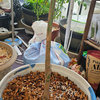Underfed mandarin?
First of all, I really want to thank all of you who have been helping me in this citrus journey of mine over the course of the last 12 months. I'm learning so much every day and I appreciate everyone who has offered suggestions!!!
This tango mandarin is still struggling. Like many others here in North San Diego, my soil is very heavy clay and slow draining. We amended the soil at planting time, but I don't think we did enough. I just fed it with EB Stone Citrus food about 3 weeks ago. Because the tree has been in the ground for one year, I followed the feeding directions for a one-year old tree and scattered one cup of the fertilizer around the drip line. So now the soil is still rather slow draining (we haven't watered in over a week, and yet the moisture meter is still reading in the green about 6-7" down). Plus I just tested the pH and it's pegged on 8 on my meter. So based on what I'm learning, here are what I think are my choices:
1. Add GrowMore chelated minerals at the next watering. Then do nothing until the next feeding time in May-June.
2. Assume I didn't feed it enough, since I've come to learn this is more likely a 4 year old tree instead of a one year old tree. Work some lime into the soil to amend the pH and add another cup of EB stone fertilizer now.
3. Work lime into the soil to amend the pH, and instead of the EB Stone, add GrowMore chelated minerals and water with liquid kelp every couple weeks until the next feeding in May-June.
4. Dig up the tree completely and add more soil amendment to the entire area, then replant the tree, and get back on the proper feeding schedule in May.
The tree did get a flush of new leaves and blooms a couple months ago, but the young fruit hasn't progressed passed beebee size and is all turning yellow, so the fruit doesn't seem to be setting. I do have about 5 or 6 fruits that reached almost normal size, and they now have the faintest blush of orange. I also have a handful of new blossoms.
{{gwi:579921}}
{{gwi:579922}}







johnmerr
bulb1776
Related Professionals
Aloha Landscape Contractors · Bedford Landscape Contractors · College Park Landscape Contractors · Elkridge Landscape Contractors · Fairfield Landscape Contractors · Mequon Landscape Contractors · Paramus Landscape Contractors · Plainview Landscape Contractors · San Pedro Landscape Contractors · Tuscaloosa Landscape Contractors · West Allis Landscape Contractors · White Bear Lake Landscape Contractors · East Norriton Landscape Contractors · Dent Stone, Pavers & Concrete · Finneytown Stone, Pavers & Concretebulb1776
johnmerr
hoosierquilt USDA 10A Sunset 23 Vista CA
bulb1776
hoosierquilt USDA 10A Sunset 23 Vista CA
vp_78Original Author
hoosierquilt USDA 10A Sunset 23 Vista CA
johnmerr
hoosierquilt USDA 10A Sunset 23 Vista CA
vp_78Original Author
hoosierquilt USDA 10A Sunset 23 Vista CA